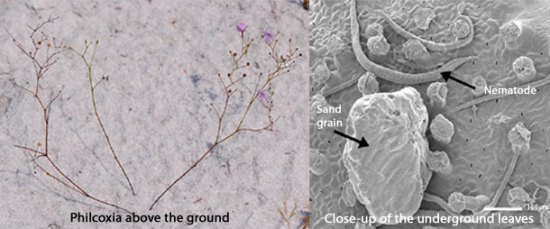Carnivorous Plant Eats Worms Using Sticky Underground Leaves
There were some seriously odd things about the plant Philcoxia, an herb which lives in the rocky, white sandy Campos Rupestres region of Brazil. For one thing, the slim, stickly plant had only tiny leaves with which to photosynthesize in a nutrient poor area. For another, it had strange, sticky underground leaves. Initially described in 2000, researchers also noted stalked capitate glands — usually a sign of a carnivorous plant. However, there were no corpses nearby to suggest any grisly business. That was until someone looked underneath the soil.
In 2007, Peter Fritsch found evidence that those adhesive, underground leaves might well be up to something. Nematodes, tiny worms that are smaller than grains of sand, were stuck to these leaves. However, Fritsch’s team wasn’t able to confirm that the plant was actually digesting these worms for sustenance.
However, new research from Unicamp’s Caio Pereira seem to confirm that Philcoxia is indeed making a meal out of those worms. In his study, Pereira bred special nematodes that were high in the rare element Nitrogen-15. He then introduced these worms to Philcoxia, and found that after two days 15% of the Nitrogen-15 in the worms had become incorporated into the leaves. This would seem to show that the plant was digesting the worms, and in doing so, the tell-tale Nitrogen.
To back up his claims, Pereira checked for phosphates on the sticky Philcoxia leaves. In other carnivorous plants, phosphates are used to break down prey. He found that the leaves were, in fact, coated with high amounts of phosphates.
In his paper, published in the Proceedings of the National Academy of the Sciences, Pereira notes that until this plant was found, no other plants in the Plantaginacae family were thought to be carnivorous. He suggests that the this could be an adaptation to cope with the relatively nutrient poor area in which the plant lives. This seems plausible since, compared to the plants around it, Philcoxia is able to bring in more nutrients.
Discover notes in their write up of the study that carnivorous plants were thought to be rare because it is less efficient than photosynthesis. However, Philcoxia could be a case study in how meat-eating can be advantagoues, and its unique way of capturing prey could mean that more plants are secretly meat eaters. That’s pure conjecture, of course, but it does change people’s impression of our otherwise unobtrusive green neighbors.
(image and story via Discover, Wikipedia)
Have a tip we should know? tips@themarysue.com
